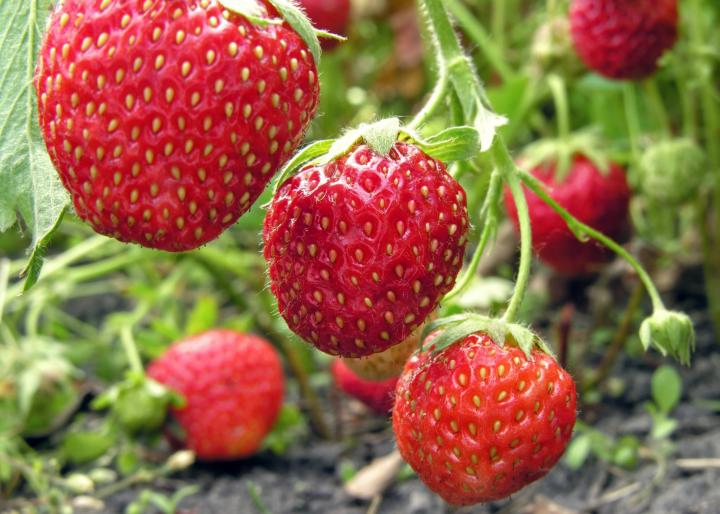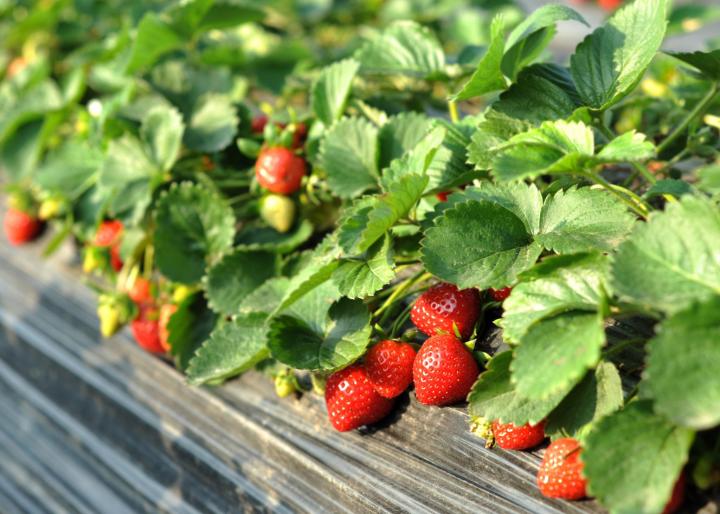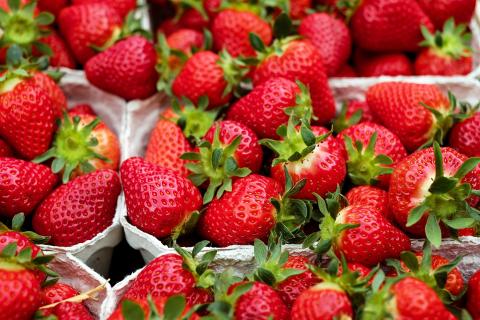Strawberries are one of the easiest fruit to grow and great for beginners! Plus, they’re very rewarding because the taste is far more flavorful than what you’ll ever find in a grocery store. Why? The sugar in berries converts to starch soon after they’re picked. Learn more about growing strawberries in the home garden.
The best thing about strawberries is that they’re very easy to grow in almost all climates and soils across the United States and Canada—as long as you plant them in a location that gets full sun.
Strawberry plants come in three types:
- June-bearing varieties bear fruit all at once, usually over a period of three weeks. Day-length sensitive, these varieties produce buds in the autumn, flowers, and fruits the following June, and runners during the long days of summer. Although called “June-bearing” or “June-bearers,” these strawberries bear earlier than June in warmer climates.
- Everbearing varieties produce a big crop in spring, produce lightly in the summer, and then bear another crop in late summer/fall. These varieties form buds during the long days of summer and the short days of autumn. The summer-formed buds flower and fruit in autumn, and the autumn-formed buds fruit the following spring.
- Day-Neutral varieties produce fruit continuously through the season, until the first frost: Insensitive to day length, these varieties produce buds, fruits, and runners continuously if temperature remains between 35° and 85°F (1° to 30°C). Production is less than that of June-bearers.
For the home garden, we recommend June-bearers. Although you will have to wait a year for fruit harvesting, it will be well worth it.
Growing Strawberries From Planting to Harvest
See some really great tips on growing strawberries in this demonstration garden—and then read the guide below for more information on every stage from planting to harvesting!
When to Plant Strawberries
- Plan to plant as soon as the ground can be worked in the spring. See your local frost dates.
- Establish new plants each year to keep berry quality high each season. Strawberry plants will produce runners (daughter plants) that will root and grow into new strawberry plants.
- Buy disease-resistant plants from a reputable nursery, of a variety recommended in your area. Consult with the nursery you buy them from or with your state Cooperative Extension service for locally recommended varieties.

Choosing and Preparing a Planting Site
- Strawberry plants require 6-10 hours a day of direct sunlight, so choose your planting site accordingly.
- Strawberries are tolerant of different soil types, although they prefer loamy soil that drains well. Ideally, begin working in aged manure or compost a couple months before planting. If you have clay soil, generally mix in 4 inches or more of compost, and rake the clay soil into raised mounds to further improve drainage. If your soil is sandy, simply cultivate lightly to remove weeds, and mix in a 1-inch layer of rich compost or rotted manure.
- Soil pH should be between 5.5 and 7. If necessary, amend your soil in advance of planting. If soils in your area are naturally alkaline, it is best to grow strawberries in half-barrels or other large containers filled with compost-enriched potting soil.
- The planting site must be well-drained. Raised beds are a particularly good option for strawberry plants.
- Practice crop rotation for the most success. Unless you plan to amend your soil each year, do not plant in a site that recently had strawberries, tomatoes, peppers, or eggplant.
How to Plant Strawberries
- Provide adequate space for sprawling. Set plants out 18 inches (1-1/2 feet) apart to leave room for runners and leave 4 feet between rows. Strawberries are sprawling plants. Seedlings will send out runners, which in turn will send out their own runners.
- Make planting holes deep and wide enough to accommodate the entire root system without bending it. However, don’t plant too deep! The roots should be covered, but the crown should be right at the soil surface. It is very important that you do NOT bury the crown (central growing bud) of the plant or it could rot. The leaves, flowers, and fruit must be exposed to light and fresh air.
- To settle their roots into the soil, water plants well at the time of planting.
- It is also possible to grow strawberries from last year’s runners. See this video to find out how.
How to Grow Strawberries
- Keep strawberry beds mulched to reduce water needs and weed invasion. Any type of mulch—from black plastic to pine straw to shredded leaves—will keep the soil moist and the plants clean. Read more about mulching.
- Be diligent about weeding. Weed by hand, especially in the first months after planting.
- Moisture is incredibly important to strawberries due to their shallow roots. Water adequately, about one inch per square foot per week. Strawberry plants need a lot of water when the runners and flowers are developing and again in the late summer, when the plants are fully mature and gearing up for winter dormancy.
- Fertilize with all-purpose granules for strong growth. In warm weather, berries ripen about 30 days after blossoms are fertilized.
- In the first year, pick off blossoms to discourage strawberry plants from fruiting. If not allowed to bear fruit, they will spend their food reserves on developing healthy roots instead, which is a good thing. The yields will be much greater in the second year.
- Eliminate runner plants as needed. First and second generations produce higher yields. Try to keep daughter plants spaced about 10 inches apart.
- Row covers are a good option for protecting blossoms and fruit from birds.

Winter Care of Strawberries
Strawberry plants are perennial. They are naturally cold hardy and will survive mildly freezing temperatures. So, if your area has mild winters, little care is needed.
In regions where the temperature regularly drops into the low twenties (Fahrenheit), strawberries will be in their dormant stage. It’s best to provide some winter protection:
- When the growing season is over, mow or cut foliage down to one inch. This can be done after the first couple of frosts, or when air temps reach 20°F (-6°C).
- Mulch plants about 4 inches deep with straw, pine needles, or other organic material.
- In even colder regions, more insulating mulch should be added.
- Natural precipitation should appropriately maintain sufficient soil moisture.
- Remove mulch in early spring, after the danger of frost has passed.
- Gray Mold
- Powdery Mildew
- Japanese Beetles
- Spider Mites
- Slugs
Pest-Beating Tips
- Keeping beds weed-free and using a gritty mulch can deter slugs and bugs. Spread sand over the strawberry bed to deter slugs. (This also works well for lettuce.) Pine needles also foil slug and pill-bug damage.
- For bigger bugs such as Japanese beetles, spray your plants with puréed garlic and neem seed oil.
- When birds threaten your strawberries, position balloons with scare-eyes above the beds and use reflective Mylar bird tape to deter them.
Try planting more than one variety. Each will respond differently to conditions, and you will have a range of different fruits to enjoy.
- ‘Northeaster’ is best suited for the northeastern US and southeastern Canada. Fruit has strong flavor and aroma.
- ‘Sable’ is hardy to zone 3, early season, great flavor.
- ‘Primetime’ is a mild-flavored, disease-resistant variety, best adapted to the Mid-Atlantic.
- ‘Cardinal’ is a good variety to try in the South.
- ‘Camarosa’ is a good variety to try on the West Coast.
- ‘Tristar’ is a day-neutral variety that’s very well-suited for hanging baskets.
Learn more about choosing and growing different strawberry varieties.
How to Harvest Strawberries
- Fruit is typically ready for harvesting 4-6 weeks after blossoming.
- Harvest only fully red (ripe) berries, and pick every three days.
- Cut by the stem; do not pull the berry or you could damage the plant.
- For June-bearer strawberries, the harvest will last up to 3 weeks. You should have an abundance of berries, depending on the variety.
How to Store Strawberries
- Store unwashed berries in the refrigerator for 3–5 days.
- Strawberries can be frozen whole for about 2 months.
- Watch our video on How to Make Strawberry Preserves!

Photo by Ben Shuchunke/Getty Images
Why Are Strawberries Called Strawberries?
One theory is that woodland pickers strung them on pieces of straw to carry them to market. Others believe that the surface of the fruit looks as if it’s embedded with bits of straw. Still others think that the name comes from the Old English word meaning “to strew,” because the plant’s runners stray in all directions and look as if they are strewn on the ground.
The June full Moon is called the Strawberry Moon because when this Moon appeared, it signaled that it was time to start gathering ripening fruit.




